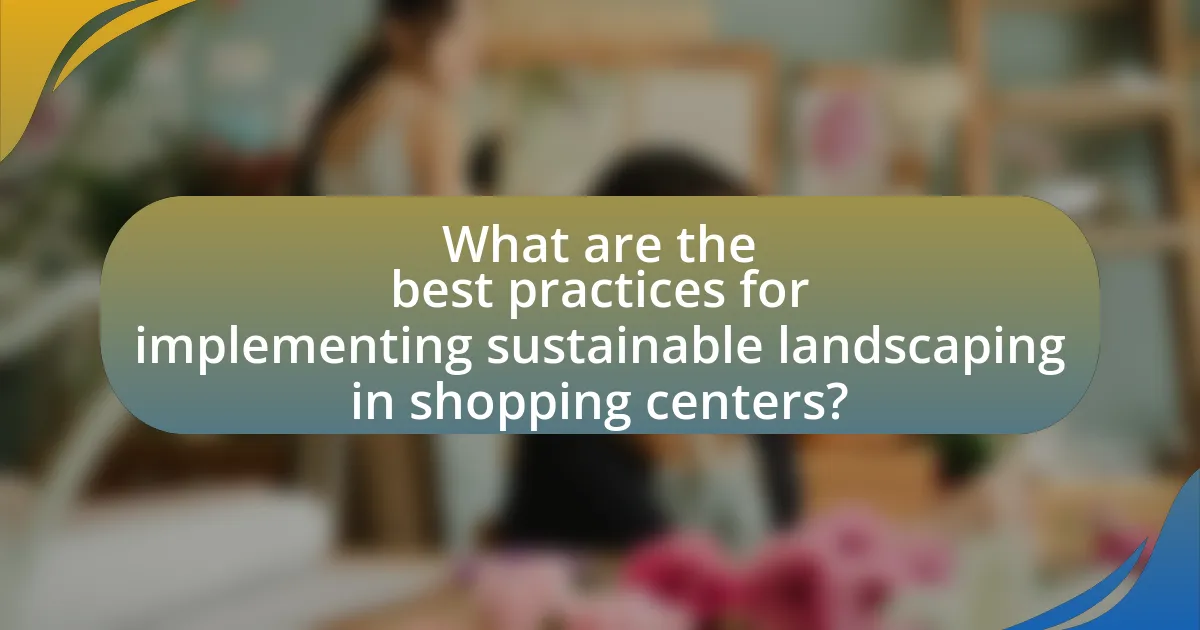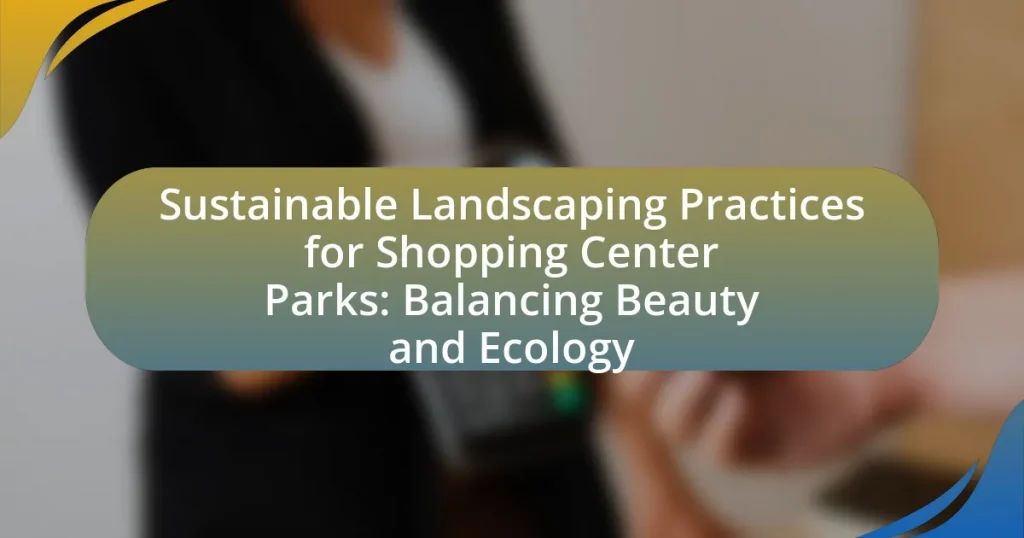Sustainable landscaping practices for shopping center parks focus on integrating ecological principles with aesthetic design to enhance both environmental health and visitor experience. Key practices include the use of native plants, efficient irrigation systems, and organic maintenance techniques, which collectively promote biodiversity, conserve water, and reduce chemical inputs. The article explores specific techniques such as xeriscaping, rainwater harvesting, and the benefits of soil health, while addressing challenges like financial barriers and misconceptions about sustainability. Additionally, it highlights successful case studies and practical tips for shopping centers to implement effective sustainable landscaping strategies that balance beauty and ecology.

What are Sustainable Landscaping Practices for Shopping Center Parks?
Sustainable landscaping practices for shopping center parks include the use of native plants, efficient irrigation systems, and organic maintenance techniques. Native plants require less water and are more resilient to local pests, reducing the need for chemical pesticides. Efficient irrigation systems, such as drip irrigation, minimize water waste by delivering water directly to the plant roots. Organic maintenance techniques, including composting and mulching, enhance soil health and reduce chemical inputs. These practices not only promote ecological balance but also create aesthetically pleasing environments that attract visitors, thereby supporting the shopping center’s economic viability.
How do these practices contribute to ecological balance?
Sustainable landscaping practices contribute to ecological balance by promoting biodiversity, enhancing soil health, and conserving water resources. These practices, such as using native plants, reduce the need for chemical fertilizers and pesticides, which can harm local ecosystems. For instance, native plants support local wildlife, including pollinators, which are essential for plant reproduction and maintaining healthy ecosystems. Additionally, sustainable landscaping techniques like rain gardens and permeable pavements help manage stormwater runoff, reducing erosion and water pollution. Research indicates that areas with diverse plant species can support a wider range of animal species, thereby fostering a more resilient ecological community.
What specific techniques are used in sustainable landscaping?
Sustainable landscaping employs specific techniques such as xeriscaping, native plant selection, rainwater harvesting, and organic gardening. Xeriscaping minimizes water use by incorporating drought-resistant plants and efficient irrigation systems, which is crucial in areas with limited water resources. Native plant selection enhances biodiversity and reduces maintenance needs, as these plants are adapted to local climates and soil conditions. Rainwater harvesting captures and utilizes rainwater for irrigation, reducing reliance on municipal water supplies. Organic gardening practices, including composting and natural pest control, promote soil health and reduce chemical inputs. These techniques collectively contribute to ecological balance while enhancing the aesthetic appeal of landscapes.
How do these techniques enhance biodiversity in shopping center parks?
Sustainable landscaping techniques enhance biodiversity in shopping center parks by creating diverse habitats that support various plant and animal species. These techniques, such as native plant selection, rain gardens, and green roofs, promote ecological balance by providing food and shelter for wildlife, improving soil health, and managing stormwater effectively. For instance, using native plants can increase local pollinator populations, as these species are adapted to the local environment and provide essential resources for bees and butterflies. Additionally, implementing rain gardens helps filter pollutants and supports aquatic ecosystems, further contributing to overall biodiversity.
Why is it important to balance beauty and ecology in landscaping?
Balancing beauty and ecology in landscaping is crucial because it ensures aesthetic appeal while promoting environmental health. A well-designed landscape enhances the visual experience for visitors, which can increase foot traffic and customer satisfaction in shopping centers. Simultaneously, incorporating ecological principles, such as native plant selection and sustainable practices, supports biodiversity, conserves water, and reduces maintenance costs. Research indicates that landscapes designed with both beauty and ecology in mind can improve air quality and provide habitats for wildlife, thereby creating a harmonious environment that benefits both people and nature.
What aesthetic benefits do sustainable practices provide?
Sustainable practices provide aesthetic benefits by enhancing the visual appeal and ecological harmony of landscapes. These practices often incorporate native plants, which not only thrive in local conditions but also contribute to biodiversity, creating vibrant and diverse ecosystems. For instance, research shows that landscapes designed with sustainable principles can increase the variety of colors and textures, making spaces more inviting and visually interesting. Additionally, sustainable landscaping can improve the overall health of the environment, leading to cleaner air and water, which indirectly enhances the aesthetic quality of the surroundings.
How can ecological considerations improve visitor experience?
Ecological considerations can enhance visitor experience by creating more engaging and immersive environments that promote well-being and connection to nature. For instance, incorporating native plants in landscaping not only supports local biodiversity but also reduces maintenance costs and water usage, leading to a more sustainable and visually appealing space. Research indicates that green spaces with diverse flora can improve mental health and increase visitor satisfaction, as evidenced by a study published in the Journal of Environmental Psychology, which found that exposure to natural environments significantly boosts mood and reduces stress levels. By prioritizing ecological practices, shopping center parks can offer visitors a more enjoyable and restorative experience.
What challenges do shopping centers face in implementing sustainable landscaping?
Shopping centers face several challenges in implementing sustainable landscaping, primarily including high initial costs, maintenance complexities, and regulatory constraints. The initial investment for sustainable materials and practices, such as native plants and efficient irrigation systems, can be significantly higher than traditional landscaping options, which may deter decision-makers. Additionally, maintaining sustainable landscapes often requires specialized knowledge and ongoing commitment, complicating management efforts. Regulatory constraints, such as zoning laws and building codes, can also limit the types of sustainable practices that can be employed, making it difficult for shopping centers to fully realize their ecological goals.
What are the common misconceptions about sustainable landscaping?
Common misconceptions about sustainable landscaping include the belief that it is unattractive, requires excessive maintenance, and is only suitable for rural areas. Many people think sustainable landscaping prioritizes function over aesthetics, but studies show that well-designed sustainable landscapes can be visually appealing while promoting biodiversity. Additionally, some believe that sustainable practices, such as native plant use, demand more upkeep; however, native plants often require less maintenance and water than non-native species. Lastly, the idea that sustainable landscaping is limited to rural settings is incorrect, as urban areas can also benefit from these practices, enhancing ecological health and community well-being.
How can shopping centers overcome financial barriers to sustainability?
Shopping centers can overcome financial barriers to sustainability by implementing cost-effective green initiatives and leveraging public-private partnerships. For instance, investing in energy-efficient systems can reduce operational costs significantly; studies show that energy-efficient buildings can save up to 30% on energy bills. Additionally, shopping centers can collaborate with local governments and organizations to access grants and funding specifically aimed at sustainability projects, which can alleviate upfront costs. Research indicates that such partnerships can enhance community engagement and provide financial incentives, making sustainable practices more feasible.
How can shopping centers measure the success of sustainable landscaping practices?
Shopping centers can measure the success of sustainable landscaping practices through metrics such as biodiversity, water usage, and customer satisfaction. Biodiversity can be assessed by monitoring the variety of plant species and wildlife present, indicating a healthy ecosystem. Water usage can be quantified by tracking irrigation needs and comparing them to traditional landscaping methods, with successful practices showing reduced water consumption. Customer satisfaction can be evaluated through surveys that gauge visitor perceptions of the landscape’s aesthetic appeal and environmental impact. These metrics provide concrete evidence of the effectiveness of sustainable landscaping initiatives.
What role do community engagement and education play in sustainable landscaping?
Community engagement and education are crucial in sustainable landscaping as they foster awareness and participation among local residents, leading to more effective and environmentally friendly practices. Engaging the community encourages individuals to take ownership of their local landscapes, promoting stewardship and sustainable behaviors. Educational initiatives, such as workshops and informational campaigns, provide essential knowledge about native plants, water conservation, and ecological benefits, which can significantly enhance the effectiveness of sustainable landscaping efforts. Research indicates that communities actively involved in landscaping decisions are more likely to adopt sustainable practices, resulting in improved biodiversity and reduced environmental impact.

What are the key components of effective sustainable landscaping?
The key components of effective sustainable landscaping include the use of native plants, efficient water management, soil health, and biodiversity enhancement. Native plants are crucial as they require less water and maintenance, promoting local ecosystems. Efficient water management practices, such as rainwater harvesting and drip irrigation, reduce water waste and support plant health. Maintaining soil health through organic amendments and minimizing chemical fertilizers fosters a thriving environment for plants. Lastly, enhancing biodiversity by incorporating a variety of plant species supports wildlife and creates resilient landscapes. These components collectively contribute to a sustainable approach that balances ecological health with aesthetic appeal in landscaping.
How does soil health impact sustainable landscaping practices?
Soil health significantly impacts sustainable landscaping practices by influencing plant growth, nutrient availability, and ecosystem balance. Healthy soil promotes robust root systems, which enhances water retention and reduces the need for irrigation, thereby conserving resources. Additionally, nutrient-rich soil supports diverse plant species, which can improve biodiversity and attract beneficial wildlife. Research indicates that healthy soils can sequester carbon, contributing to climate change mitigation, and studies show that landscapes with healthy soils require fewer chemical inputs, aligning with sustainable practices. For instance, a study published in the journal “Soil Biology and Biochemistry” found that improved soil health can lead to a 30% increase in plant productivity, underscoring its critical role in sustainable landscaping.
What methods can improve soil quality in shopping center parks?
Methods to improve soil quality in shopping center parks include organic amendments, cover cropping, and proper drainage management. Organic amendments, such as compost and mulch, enhance soil structure and nutrient content, promoting healthier plant growth. Cover cropping, which involves planting specific crops during off-seasons, prevents soil erosion and improves soil fertility through nitrogen fixation. Proper drainage management prevents waterlogging and soil compaction, ensuring optimal conditions for root development. These methods collectively contribute to sustainable landscaping practices, enhancing both ecological balance and aesthetic appeal in shopping center parks.
How does soil health relate to plant selection and maintenance?
Soil health directly influences plant selection and maintenance by determining the nutrient availability, water retention, and overall ecosystem balance necessary for plant growth. Healthy soil, characterized by a diverse microbial community and optimal pH levels, supports a wider variety of plants, allowing for the selection of species that are well-suited to the specific conditions of the site. For instance, research indicates that soils with high organic matter content can retain moisture better, which is crucial for drought-resistant plant species, thereby reducing maintenance needs. Additionally, plants selected for their compatibility with the soil’s health can thrive with less intervention, minimizing the need for fertilizers and pesticides, which aligns with sustainable landscaping practices.
What types of plants are best suited for sustainable landscaping in shopping centers?
Native plants are best suited for sustainable landscaping in shopping centers. These plants are adapted to the local climate and soil conditions, requiring less water and maintenance compared to non-native species. For example, using native grasses, shrubs, and trees can enhance biodiversity, support local wildlife, and reduce the need for chemical fertilizers and pesticides. Studies show that native landscaping can decrease water usage by up to 50% compared to traditional landscaping methods, making it an environmentally friendly choice for shopping centers.
How do native plants contribute to sustainability goals?
Native plants contribute to sustainability goals by enhancing biodiversity, improving soil health, and reducing water usage. These plants are adapted to local climates and ecosystems, which allows them to thrive with minimal maintenance and resources. For instance, studies show that native plants support a wider range of pollinators and wildlife, thereby promoting ecological balance. Additionally, they often require less irrigation compared to non-native species, which conserves water resources. Research indicates that landscapes featuring native plants can reduce stormwater runoff and improve soil quality, further supporting environmental sustainability.
What are the benefits of using drought-resistant plants?
Drought-resistant plants offer significant benefits, including reduced water usage, lower maintenance costs, and enhanced ecological resilience. These plants are adapted to survive in arid conditions, which means they require less irrigation compared to traditional landscaping plants. For instance, studies show that using drought-resistant species can decrease landscape water consumption by up to 50%, leading to substantial savings in water bills and resources. Additionally, these plants often require less fertilizer and pesticide, promoting a healthier ecosystem. Their ability to thrive in challenging conditions also supports biodiversity by providing habitats for various wildlife, contributing to a balanced ecological environment in shopping center parks.
How can water management be optimized in shopping center parks?
Water management in shopping center parks can be optimized through the implementation of efficient irrigation systems, rainwater harvesting, and the use of drought-resistant landscaping. Efficient irrigation systems, such as drip irrigation, deliver water directly to plant roots, minimizing waste and evaporation. Rainwater harvesting systems can collect and store rainwater for irrigation, reducing reliance on municipal water supplies. Additionally, incorporating drought-resistant plants reduces water consumption and enhances the park’s resilience to dry conditions. Studies show that these practices can lead to a 30-50% reduction in water usage, demonstrating their effectiveness in sustainable landscaping.
What techniques can reduce water usage in landscaping?
Techniques that can reduce water usage in landscaping include xeriscaping, using native plants, implementing drip irrigation systems, and applying mulch. Xeriscaping focuses on designing landscapes that require minimal irrigation by selecting drought-resistant plants and optimizing soil conditions. Native plants are adapted to local climates and typically require less water than non-native species. Drip irrigation systems deliver water directly to the plant roots, minimizing evaporation and runoff, which can save up to 60% more water compared to traditional sprinkler systems. Additionally, applying mulch helps retain soil moisture, reduces evaporation, and suppresses weeds, further contributing to water conservation in landscaping.
How does rainwater harvesting work in a shopping center context?
Rainwater harvesting in a shopping center context involves the collection and storage of rainwater from rooftops and paved surfaces for reuse. This system typically includes gutters and downspouts that channel rainwater into storage tanks or cisterns, which can then be utilized for irrigation, toilet flushing, or other non-potable uses. Implementing rainwater harvesting can significantly reduce water consumption and stormwater runoff, contributing to sustainability goals. For instance, a study by the Environmental Protection Agency indicates that rainwater harvesting can reduce water usage by up to 50% in commercial settings, demonstrating its effectiveness in promoting ecological balance within shopping center parks.

What are the best practices for implementing sustainable landscaping in shopping centers?
The best practices for implementing sustainable landscaping in shopping centers include selecting native plants, utilizing efficient irrigation systems, and incorporating permeable surfaces. Native plants require less water and maintenance, promoting biodiversity and reducing the need for chemical fertilizers and pesticides. Efficient irrigation systems, such as drip irrigation, minimize water waste and ensure that plants receive adequate moisture. Permeable surfaces allow rainwater to infiltrate the ground, reducing runoff and promoting groundwater recharge. These practices not only enhance the aesthetic appeal of shopping centers but also contribute to environmental sustainability by conserving resources and supporting local ecosystems.
How can shopping centers create a sustainable landscaping plan?
Shopping centers can create a sustainable landscaping plan by implementing native plant species, utilizing efficient irrigation systems, and incorporating green infrastructure. Native plants require less water and maintenance, promoting biodiversity and reducing the need for chemical fertilizers and pesticides. Efficient irrigation systems, such as drip irrigation, minimize water waste and ensure that plants receive adequate moisture. Additionally, integrating green infrastructure, like rain gardens and permeable pavements, helps manage stormwater runoff and enhances the ecological health of the area. These practices not only contribute to environmental sustainability but also improve the aesthetic appeal of shopping centers, attracting more visitors.
What steps should be taken during the planning phase?
During the planning phase of sustainable landscaping for shopping center parks, the key steps include conducting a site analysis, defining project goals, selecting appropriate plant species, and creating a design plan. Conducting a site analysis involves assessing soil quality, existing vegetation, and microclimates to inform design decisions. Defining project goals ensures alignment with sustainability objectives, such as water conservation and biodiversity enhancement. Selecting appropriate plant species focuses on native and drought-resistant plants that require less maintenance and support local wildlife. Finally, creating a design plan integrates these elements into a cohesive layout that balances aesthetic appeal with ecological functionality. These steps are essential for achieving a sustainable landscape that meets both environmental and aesthetic standards.
How can ongoing maintenance be integrated into the landscaping plan?
Ongoing maintenance can be integrated into the landscaping plan by establishing a detailed schedule that outlines regular tasks such as pruning, fertilizing, and irrigation. This schedule should align with the specific needs of the plant species used in the landscaping, ensuring that maintenance activities support their growth and health. For instance, native plants often require less water and fewer chemical inputs, making them easier to maintain sustainably. Additionally, incorporating technology such as automated irrigation systems can optimize water usage and reduce labor costs. Studies show that well-maintained landscapes not only enhance aesthetic appeal but also contribute to ecological health by supporting local wildlife and reducing runoff.
What are some successful case studies of sustainable landscaping in shopping centers?
Successful case studies of sustainable landscaping in shopping centers include the Westfield Valley Fair in California and the Mall of America in Minnesota. At Westfield Valley Fair, the landscaping incorporates native plants, which require less water and maintenance, and features permeable paving to manage stormwater runoff effectively. This approach not only enhances biodiversity but also reduces irrigation costs by 30%. The Mall of America has implemented a green roof and rain gardens that capture and filter rainwater, significantly decreasing the site’s environmental footprint. These initiatives demonstrate how sustainable landscaping can improve ecological health while providing aesthetic value to shopping centers.
What lessons can be learned from these case studies?
The lessons learned from the case studies on sustainable landscaping practices for shopping center parks emphasize the importance of integrating ecological principles with aesthetic design. These case studies demonstrate that utilizing native plant species enhances biodiversity and reduces maintenance costs, as native plants are better adapted to local conditions. Additionally, implementing water-efficient irrigation systems significantly lowers water usage, contributing to sustainability goals. The case studies also highlight the value of community engagement in the design process, which fosters a sense of ownership and encourages stewardship of green spaces. Overall, these lessons underscore the effectiveness of combining beauty with ecological responsibility in landscaping practices.
How can these examples inspire other shopping centers?
These examples can inspire other shopping centers by demonstrating effective sustainable landscaping practices that enhance both aesthetic appeal and ecological balance. For instance, implementing native plant species reduces water usage and maintenance costs while supporting local biodiversity. Research shows that shopping centers adopting sustainable landscaping can see a 20-30% reduction in water consumption, as evidenced by case studies from various eco-friendly developments. Additionally, integrating green spaces and permeable surfaces can improve stormwater management, leading to healthier urban ecosystems. By showcasing these successful strategies, other shopping centers can adopt similar practices to attract environmentally conscious consumers and contribute positively to their communities.
What practical tips can shopping centers follow to enhance their landscaping sustainability?
Shopping centers can enhance their landscaping sustainability by implementing native plant landscaping, which reduces water usage and maintenance costs. Native plants are adapted to local climates and soil conditions, requiring less irrigation and fewer chemical fertilizers or pesticides. Additionally, shopping centers can incorporate rain gardens to manage stormwater runoff effectively, promoting groundwater recharge and reducing pollution. Utilizing permeable paving materials can also help manage water drainage while minimizing heat island effects. Furthermore, integrating composting and mulching practices can improve soil health and reduce waste. These strategies collectively contribute to a more sustainable landscape that balances aesthetic appeal with ecological responsibility.















